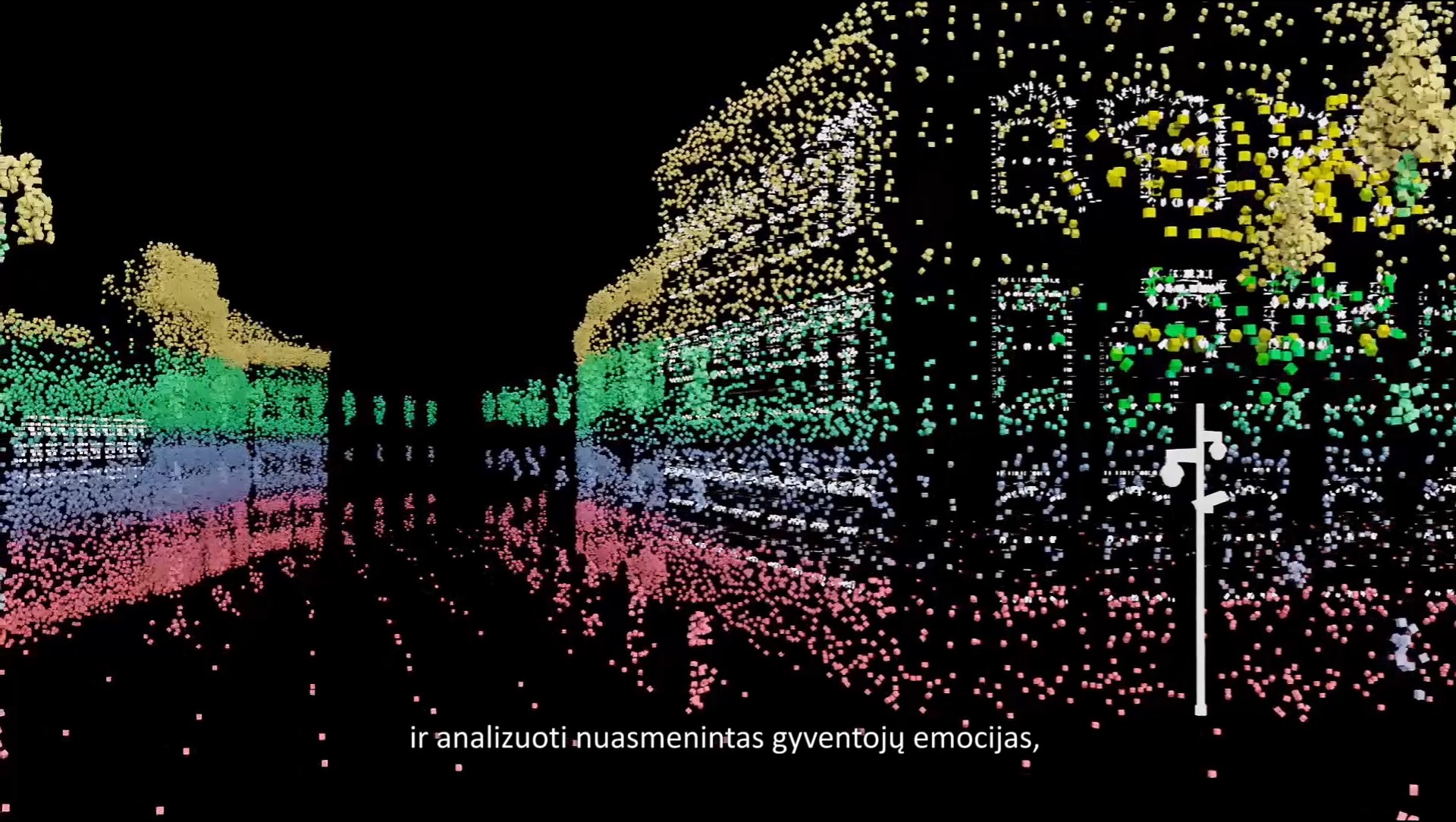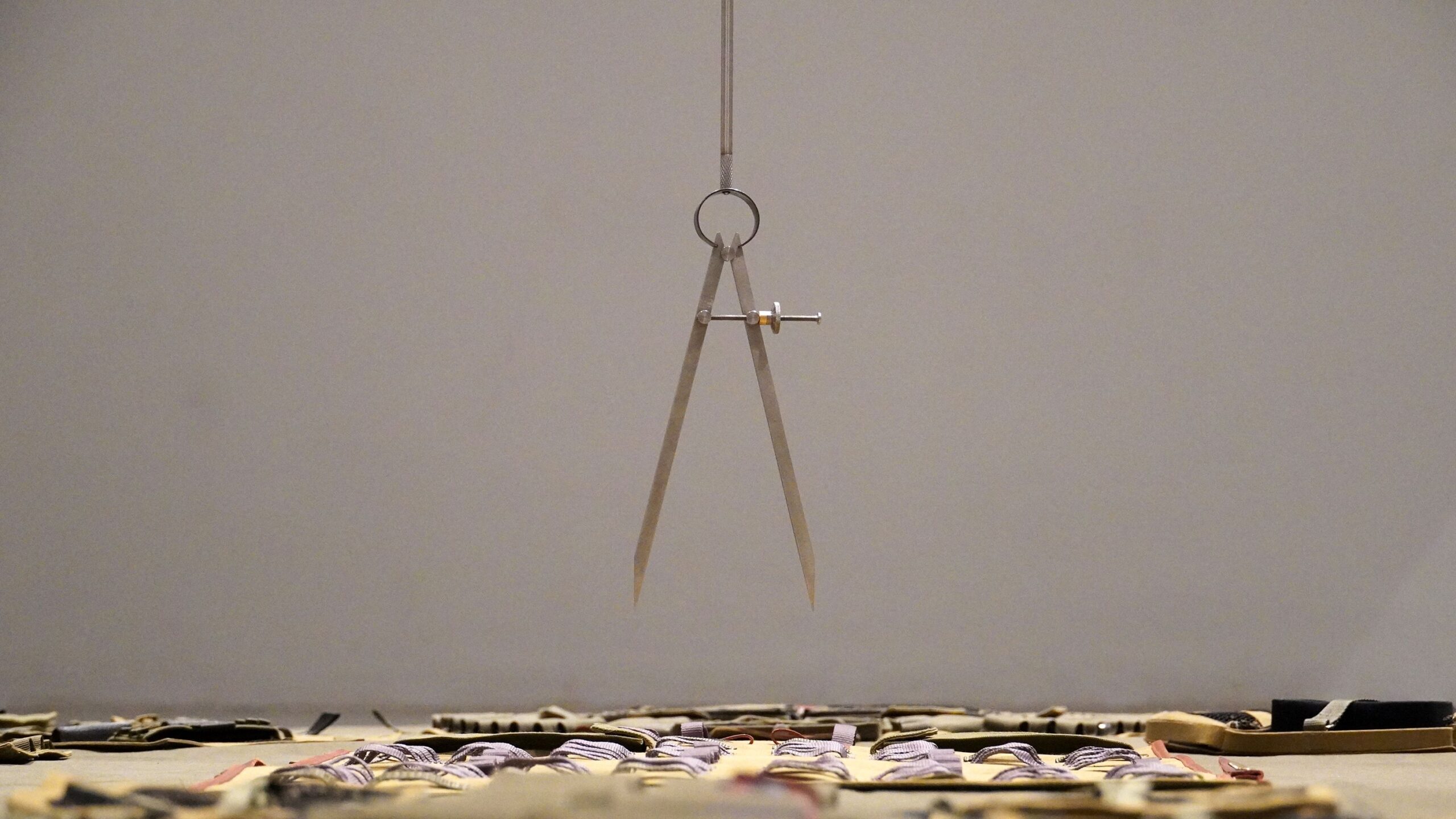THE FIELD FOLDS by Audrius Novickas
1 December 2023 – 3 March 2024
The solo exhibition presents two new works: the video Vitrine Morte and the installation Pendulum. The two separate works are connected through the idea of an open field. The field is interpreted as a space without stable boundaries that can be perceived from infinite different perspectives. Because of them, the field becomes a continuously re-established social and political territory where individual and collective subjects engage in multifaceted and contradictory practices of identity construction. These practices are never fully transparent, as the participation of the subjects is influenced by the subconscious, their repressed desires and differences. The fragmentations and instabilities inherent in the social processes taking place in the open field and the spatial forms associated with them allow us to observe, explore and dramatize their misrecognition. In both works, misrecognitions of processes and structures are reflected through visual narratives that fall between documentary and the imaginary. They raise issues of identity, power and the politics of memory, which are also relevant to the artist’s earlier work. These issues are explored as if in folds, dissecting and recombining the imagery of various temporalities, spaces and social practices. But are all the folds on the same plane? Or are different fields folding onto each other in layers?
Both works are based on iconographic material of cities but the installation Pendulum uses it as a metaphor for social engineering, while in the film Vitrine Morte, it acts as a thoughtful dedication to Vilnius, the artist’s home city.

VITRINE MORTE
HD video, 8’28”, 2022
3D graphics and animation – Dovydas Gaižauskas
Sound – Darius Čiuta
3D scanning – Žilvinas Lilas
Archival material and expert assistance provided by Vilnius Film Bureau, Juratė Pazikaitė and Artūras Kaklauskas
The film Vitrine Morte combines three narratives about the mutating perspectives from which Vilnius can be observed, and the kaleidoscopic jigsaw puzzles of the city that reveal themselves at their intersection.
The starting point of the first narrative is the pharmacy Pod Labędziem (Under the Swan or simply Swan) in Vilnius, once owned by the family of the Polish singer and actor Marylia Rodowicz that had an iconic porcelain swan in its window for many years. The swan was thought to have disappeared when the pharmacy closed down at the end of the 20th century, until an optician in Vilnius placed a similar-looking decoration in their window. Many Vilnius residents were convinced that it was the original item, only relocated, but a few years ago, an anonymous person donated the missing swan to a museum in Kaunas.
A swan that wanders from one shop window to the next, where the original and the replica blend together, is akin to the imagery of a flaneur, such as in Charles Baudelaire’s poem The Swan. Baudelaire saw a swan in shop window reflections in a rapidly modernising city. For generations of ‘swan seekers’ that followed Baudelaire, the development of glass technology opened up the possibility of observing and documenting the city through optical apparatuses, i.e., not only directly but also virtually, with a cinematographic gaze.
Today, cinema influences the way we visually experience a city not just as a medium, but also due to the global proliferation of film sets. Therefore, the second narrative of the film is about Vilnius as a warehouse of film sets, where one can find backdrops and scenery suitable to depict the most diverse places in the world, as well as Vilnius as a global tourist destination where tourists inspired by cinema become immersed in virtual temporal and spatial experiences within the real city.
In a city that is being explored virtually, the ‘swan’, as an easily recognisable and nostalgic image, could easily become the ‘black swan’, whose disturbing appearance can neither be predicted nor avoided. The possibility of encountering the ‘black swan’ encourages us to entrust even more city observation tasks to machines. In today’s smart city, these apparatuses are increasingly tracking and analysing us, as well as taking and exerting control.
The third narrative of Vilnius is about the panopticon mode, which is being implemented through the broad proliferation of electronic devices and artificial intelligence applications. One example of such a panopticon is the joint project between researchers and the municipality of Vilnius that collects residents’ neuro-analytical data in public spaces in order to monitor their happiness index.

PENDULUM
Installation: 4×3 m carpet (tarpaulin, leather, elements of metal and textile), pendulum (metal rod, precision measuring tool, programmed mechatronic device), 2023
The installation consists of a pendulum and a carpet, which is also a scaled-up expedition instrument pouch. The carpet patterns are based on plans of both ideal cities and concentration camps. An instrument for anthropometric and cartographic measurements is suspended in place of the weight that tensions the pendulum rod. As the tool oscillates, it seems to be searching for its place in an empty instrument holster, while at the same time measuring the distances and differences between the ideal cities and the concentration camps.
The installation reflects on the contradictory forms of world knowledge and social engineering through the phenomenon of the expedition. Expeditions – exploratory excursions usually initiated in metropolitan centres of power and knowledge – have combined the belief in science with the belief in organising society through policy: first in the form of an empire and later, a nation. The scientific nature of expeditions stemmed from the belief that an understanding of natural and cultural phenomena, human nature and the existence of communities could be attained through supposedly rational methods of observation, research, calculation and typology. Through expeditionary practices, the inherent human need to discover and understand, and to expand knowledge, became intertwined with stereotypes, fears and the desire to control, manipulate and even destroy that which is difficult to recognise and categorise.
The work was also inspired by the case of a little-known 1934 expedition that studied Karaims in Poland and Lithuania. It was organised by professor Corrado Gini, a renowned statistician, demographer and eugenicist, who led the Italian Committee for Population Studies in carrying out 10 expeditions on four continents between 1933 and 1938, studying isolated and primitive communities and their way of life within ethnic islands. The results of the anthropological study of the Karaims shaped the discourse on the ethnic origin of this community and identified its genetic character.
In the context of looming Holocaust, the expedition may have influenced the decision regarding the survival of the Karaim community. Perhaps it did, as the Karaim communities of Lithuania and Poland avoided systematic persecution during the Second World War.
The plans of Paneriai, Auschwitz-Birkenau, Dachau, Sachsenhausen and Treblinka concentration camps were used to create the carpet patterns, alongside unrealised plans for modern cities like Addis Ababa (Le Corbusier), Algiers (Le Corbusier), Brasilia (Oscar Niemeyer), Chaux (Claude-Nicolas Ledoux), and unknown ideal cities designed by Vincenzo Scamozzi and Albrecht Dürer.
Coordinator Viltė Visockaitė
Graphic designer Vytautas Volbekas
The project is financed by: Lithuanian Council for Culture, Lithuanian Interdisciplinary Artists’ Association
Radvila Palace Museum of Art,
24 Vilniaus st, LT-01402, Vilnius, Lithuania
+370 5 250 5824













